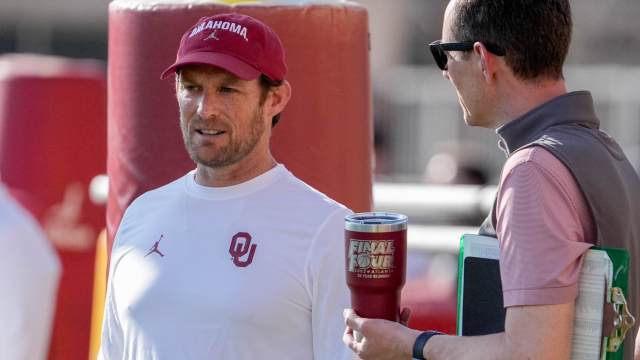The Oklahoma Sooners possess the necessary talent and skill to contend for a national championship in 2025, positioning themselves as strong contenders in college football’s top tier.

The Oklahoma Sooners, one of college football’s most storied programs, have long been associated with excellence, tradition, and a relentless pursuit of national titles. As the 2025 season approaches, many analysts and fans believe the team is well-positioned to compete at the highest level, armed with a talented roster, strategic coaching, and a robust recruiting pipeline. This assessment isn’t made lightly; it is rooted in a comprehensive understanding of Oklahoma’s current strengths, future prospects, and the evolving landscape of college football. To appreciate their potential to contend for the 2025 national championship, one must examine multiple facets, including talent acquisition, player development, coaching strategies, competition, and institutional support.
Historical Context and Program Legacy
Oklahoma’s football history is rich and illustrious, marked by multiple national championships, legendary players, and a tradition of excellence under revered coaches like Bud Wilkinson, Barry Switzer, and Bob Stoops. The program’s legacy has created a culture of winning and high expectations that continue to shape its identity today.
In recent years, Oklahoma has maintained its status as a powerhouse, regularly competing for conference titles and making deep runs in the College Football Playoff (CFP). The transition from Bob Stoops to Lincoln Riley, and subsequently to Brent Venables as head coach, reflects a commitment to adapting and evolving to meet modern football demands. This evolution centers on building competitive rosters capable of competing for the ultimate prize: the national championship.
Talent Acquisition: Building a Championship-Ready Roster
1. Recruiting Excellence and Talent Pipeline
Oklahoma’s reputation as a recruiting powerhouse plays a crucial role in their championship aspirations. The program consistently lands top-tier prospects nationally, thanks to its storied history, high-profile coaching staff, and state-of-the-art facilities. The 2024 recruiting class, for instance, included several four- and five-star athletes, particularly at critical positions such as quarterback, defensive line, and skill positions.
Looking ahead to 2025, the team’s recruiting efforts are focused on securing elite prospects who can make immediate impacts and develop into future stars. Oklahoma’s coaching staff emphasizes identifying versatile players with high football IQ, athleticism, and leadership qualities. Their recruiting strategy also involves building relationships locally in Texas, Oklahoma, and surrounding states, while expanding reach nationally to attract under-the-radar talents.
2. Transfer Portal and Immediate Impact Players
The transfer portal has become a vital component of roster building in modern college football. Oklahoma has strategically utilized the portal to acquire experienced players who can fill specific needs immediately, such as veteran offensive linemen, experienced linebackers, or skilled wide receivers. This approach accelerates competitiveness and provides a balance of youthful talent and seasoned performers.
3. Development of Homegrown Talent
Recruiting is only part of the equation; developing talent is equally essential. Oklahoma’s player development programs focus on refining technical skills, strength conditioning, mental toughness, and football IQ. Their facilities—such as the Gaylord Family – Oklahoma Memorial Stadium and the adjacent training complex—offer state-of-the-art resources to maximize player potential.
Coaching Strategies and Philosophy
1. Leadership Under Brent Venables
Head coach Brent Venables, a former Oklahoma assistant and a defensive mastermind, emphasizes discipline, effort, and a balanced approach to offense and defense. His defensive background influences a focus on creating a tough, physical team capable of shutting down high-powered offenses—an essential trait for championship contention.
2. Offensive Innovation
While Oklahoma traditionally boasts a potent offense, especially under Lincoln Riley’s Air Raid system, Venables and his staff are integrating a more balanced, physical style of play. This includes emphasizing a strong running game, versatile offensive line play, and efficient quarterback development. The team aims to adapt to modern defensive schemes while maintaining explosive offensive capabilities.
3. Defensive Resurgence
Historically, Oklahoma has faced criticism for inconsistent defensive performance. Under Venables, a defensive specialist, the focus is on building a stout, disciplined defense that can withstand high-pressure situations. This includes innovative schemes, aggressive pass rushes, and advanced film study to exploit opponents’ weaknesses.
Player Development and Talent Growth
1. Quarterback Position
The quarterback is often the difference-maker in college football. Oklahoma has prioritized recruiting and developing high-potential quarterbacks, with recent examples including Dillon Gabriel and Spencer Rattler. For 2025, the program aims to develop a signal-caller with the arm talent, mobility, and leadership qualities necessary for a championship run.
2. Skill Position Players
Oklahoma’s offensive skill positions—wide receivers and running backs—are vital for explosive plays. The team has recruited versatile athletes capable of creating mismatches and making big plays. Player development focuses on route running, hands, and understanding defensive schemes to maximize on-field impact.
3. Defensive Playmakers
The defense must produce game-changing plays—interceptions, sacks, tackles for loss. Oklahoma’s recruiting and development efforts target dynamic linebackers, shutdown cornerbacks, and disruptive defensive linemen who can anchor a championship defense.
4. Strength and Conditioning
Elite college teams invest heavily in physical development. Oklahoma’s strength and conditioning staff employ advanced techniques to ensure players peak physically during critical moments of the season, reducing injuries and increasing durability.
Competition Landscape: Who Stands in the Way?
Contending for a national championship requires overcoming formidable opponents. In 2025, Oklahoma will face stiff competition from traditional powers and rising programs alike.
1. SEC Powerhouses
As Oklahoma joins the SEC, the level of competition intensifies. Teams like Alabama, Georgia, LSU, and Florida have established dominance and possess loaded rosters. The challenge is to match or surpass their recruiting prowess and execute game plans effectively.
2. Other Top-Tier Programs
Clemson, Ohio State, Michigan, and USC remain perennial contenders. Oklahoma’s ability to adapt to their styles of play and execute consistently will determine their championship viability.
3. Developing a Competitive Edge
Oklahoma must leverage its recruiting advantage, innovative coaching, and player development to gain an edge over these rivals. Building depth, maintaining injury resilience, and executing in high-pressure situations are essential.
Institutional Support and Infrastructure
1. Facility Upgrades and Support Staff
Oklahoma’s investment in cutting-edge facilities, analytics, sports medicine, nutrition, and mental health services provides a competitive advantage. These resources help develop players physically and mentally.
2. Fan Support and Culture
A passionate fan base, tradition of excellence, and vibrant campus culture contribute to team morale and motivation. The atmosphere at the Gaylord Family Stadium often provides a home-field advantage.
3. Strategic Planning and Vision
The administration’s commitment to sustained excellence, combined with a clear vision under Brent Venables, ensures that Oklahoma remains focused on long-term success, with the ultimate goal of winning the national championship.
Broader Implications and Outlook
If Oklahoma leverages its talent, coaching, and infrastructure effectively, it stands a strong chance of competing for the 2025 title. Their recruiting pipeline is robust, their coaching staff is experienced and innovative, and their player development programs are designed to maximize potential. However, they must also navigate the challenges posed by stiff competition, injuries, and the unpredictable nature of college football.
Looking ahead, Oklahoma’s strategic focus on balancing recruiting, development, and tactical innovation positions them well. Their rich football tradition, combined with modern resources and a relentless drive to win, makes them a formidable contender. Success in 2025 will depend on executing their plans, staying healthy, and rising to the occasion when it matters most.
The Oklahoma Sooners possess the talent, skill, and strategic positioning to contend for the 2025 national championship. Their combination of a rich football legacy, ongoing recruiting excellence, innovative coaching, and commitment to player development creates a formidable foundation for a title run. While challenges exist, Oklahoma’s comprehensive approach—focusing on talent acquisition, tactical adjustments, and infrastructural support—puts them in a strong position to vie for the sport’s highest honor. If they continue to execute at the highest levels, the 2025 season could see Oklahoma return to the pinnacle of college football, fulfilling their storied tradition and cementing their legacy among the sport’s elite.









